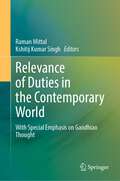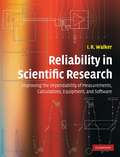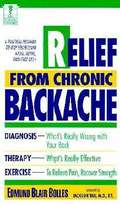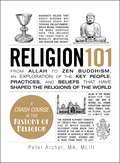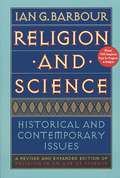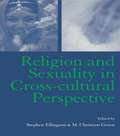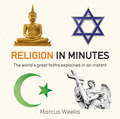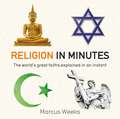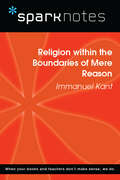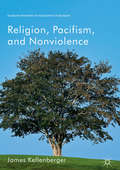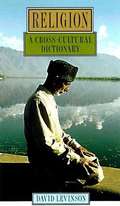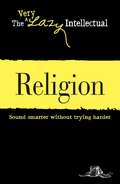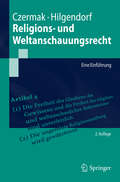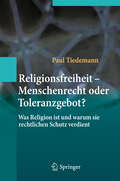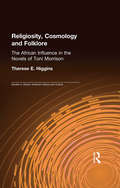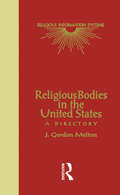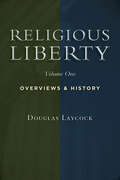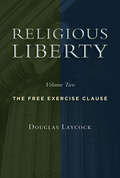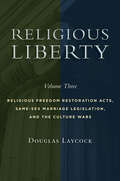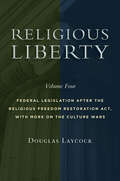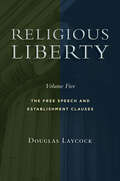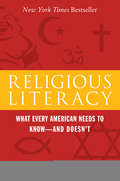- Table View
- List View
Relevance of Duties in the Contemporary World: With Special Emphasis on Gandhian Thought
by Kshitij Kumar Singh Raman MittalThis book reflects on the significance of duties in creating an egalitarian society by collating and contextualizing the relevant literature. It particularly focuses on an appreciation of Gandhi’s views on duty to showcase how they remain pertinent to create a cohesive, responsible and value-based society in the present right-dominated world. A viable solution to the current real world problems could be found in exploring the philosophy on duties and the book provides relevant literature in this regard. It undertakes jurisprudential analysis of duty in a rights-dominated world, identifying the gaps in realising the potential of duty to address the critical issues of the present times. It argues that enforcement of rights depends heavily on the observance of duties and proposes coherence in right-duty relationship. Gandhian thought on duty recognises duty as a precursor to rights and emphasises that the observance of duties guarantees the enforcement of rights. The relevance of duties and Gandhian thoughts on the same is not restricted to India but transcends borders with profound appeal. Gandhian thoughts have become even more relevant in the current times to examine the situation of COVID-19 pandemic, racial discrimination (BLM), environmental crises, digital divide, health care and medical care crises, refugee and migrant labour problems and it can offer promising solutions based on the nuances of social solidarity, self realisation of duties/responsibilities, local governance, compassion and humanity.
Reliability in Scientific Research
by I. R. WalkerCovering many techniques widely used in research, this book will help researchers in the physical sciences and engineering solve troublesome - and potentially very time consuming - problems in their work. The book deals with technical difficulties that often arise unexpectedly during the use of various common experimental methods, as well as with human error. It provides preventive measures and solutions for such problems, thereby saving valuable time for researchers. Some of the topics covered are: sudden leaks in vacuum systems, electromagnetic interference in electronic instruments, vibrations in sensitive equipment, and bugs in computer software. The book also discusses mistakes in mathematical calculations, and pitfalls in designing and carrying out experiments. Each chapter contains a summary of its key points, to give a quick overview of important potential problems and their solutions in a given area.
Reliability in Scientific Research
by I. R. WalkerClinical Manual of Emergency Pediatrics, 5th edition, is a concise, portable handbook summarizing the wide range of conditions encountered in pediatric emergency departments. As children with acute problems often receive care in private offices and clinics, it is equally relevant for pediatricians, emergency medicine physicians, family practitioners and internists. The 5th edition of this hugely successful resource is the leading book of its kind for several reasons: - Clear, concise guidance is given for patient evaluation and follow-up and explicit indications for admission - Every chapter is organized in a standard format, making it very easy for a reader to locate critical information rapidly - A dedicated 'Special Considerations' chapter addresses difficult problems such as the crying infant and the cross-cultural encounter Numerous new topics are included, making Clinical Manual of Emergency Pediatrics, 5th edition an invaluable resource for any physician working in acute care settings where children are seen.
Relief from Chronic Backache
by Edmund Blair BollesHere is the tested, proven regimen that will ease the pain that holds you hostage and restore your back to full physical function. Here is the book that debunks the myths about backache. Complete with self-exams that test your attitude toward pain, an extensive glossary, and much more to help you ease your back pain and put you in charge of your life -- for good!
Religion 101: From Allah to Zen Buddhism, an Exploration of the Key People, Practices, and Beliefs that Have Shaped the Religions of the World (Adams 101 Series)
by Peter ArcherDiscover the origins and traditions of world religions!With so many religions in the world, it isn't always easy to recall each faith's key influences, spiritual figures, and dogmas. Written in easy-to-understand language, Religion 101 offers a fascinating--and memorable--glimpse at the sacred stories, traditions, and doctrines that have influenced today's most popular religions.From Jesus and the Four Noble Truths to the Buddhist Wheel of Existence, this book provides you with thought-provoking insight into the customs and beliefs of common faiths like Christianity, Judaism, Buddhism, and Islam. Inside, you will also discover hundreds of important religious facts, illustrations, and thought puzzles that you won't be able to find anywhere else.So whether you're looking to unravel the mysteries of existence and meaning, or just want to find out what Kabbalah is all about, Religion 101 has all the answers--even the ones you didn't know you were looking for.
Religion and Science
by Ian G. BarbourReligion and Science is a definitive contemporary discussion of the many issues surrounding our understanding of God and religious truth and experience in our understanding of God and religious truth and experience in our scientific age. This is a significantly expanded and feshly revised version of Religion in an Age of Science, winner of the American Academy of Religion Award for Excellence and the Templeton Book Award. Ian G. Barbour--the premier scholar in the field--has added three crucial historical chapters on physics and metaphysics in the seventeenth century, nature and God in the eighteenth century, and biology and theology in the nineteenth century. He has also added new sections on developments in nature-centered spirituality, information theory, and chaos and complexity theories.
Religion and Sexuality in Cross-Cultural Perspective
by M. Christian Green Stephen EllingsonIssues of sexuality and gender are hotly contested in both religious communities and national cultures around the world. In the social sciences, religious traditions are often depicted as inherently conservative or even reactionary in their commitments to powerful patriarchal and pronatalist sexual norms and gender categories. In illuminating the practices of religious traditions in various cultures, these essays expose the diversity of religious rituals and mythologies pertaining to sexuality. In the process the contributors challenge conventional notions of what is normative in our sexual lives.
Religion in China
by K. Hughes E. R. HughesFirst published in 1950.Beginning with ancient times, this volume shows how some of the early superstitions became purified through the influence of the Confucianist philosophy, how a deep strain of mysticism came from the Taoists and how thereby a worship of 'Heaven' and 'Earth' was evolved. Besides the main streams of Confucianism and Buddhism, the introduction and development of Christianity into China is also analyzed.
Religion in Minutes (IN MINUTES)
by Marcus WeeksLearn about the religions of the world - in minutes. What are the differences between Sunni and Shi'a, Catholic and Protestant, Buddhism and Confucianism? Who were Moses, Jesus and Muhammad, and what did they really preach? Why are the concepts of karma, jihad and nirvana so important? And what do the religions of the world say about life, death and how we should act? Answering these and many other critical questions, this book explains the histories, key texts, prophets and essential teachings of the ancient and modern religions and their offshoots, including: Judaism, Christianity, Islam, Hinduism, Buddhism, Sikhism, Greek, Roman and Norse mythologies, indigenous traditional religions, Zoroastrianism, Jainism, Daoism, Confucianism, Shinto, Catholicism, Protestantism, Anglicanism, Baptists, Methodists, Puritans, Mormons, Sufism, Hasidism, Scientology, Baha'I, New pagans and many more, as well as considering their common themes and the future of religion.Clear, concise and with 200 iconic images, Religion in Minutes is the fastest, fullest way to understand the beliefs that shape the world around us.
Religion in Minutes (In Minutes)
by Marcus WeeksReligion in Minutes covers everything you need to know about faith and religious practices around the world, condensed into key topics, and focused on the major world religions of Christianity, Judaism, Hinduism, Buddhism, Jainism, Sikhism, and Islam.Each faith is described, including the sacred texts, religious artifacts, rites and ceremonies, practices and traditions, art and architecture. Also includes a map, time line, and history of each religion for a thorough study of the diverse ways people worship around the world.Following the latest research showing that the brain best absorbs information visually, each description is accompanied by illustrations to aid quick comprehension and easy recollection. This convenient and compact reference book is ideal for anyone interested in touching on the major religions of the world.
Religion within the Boundaries of Mere Reason (SparkNotes Philosophy Guide)
by SparkNotesReligion within the Boundaries of Mere Reason (SparkNotes Philosophy Guide) Making the reading experience fun! SparkNotes Philosophy Guides are one-stop guides to the great works of philosophy–masterpieces that stand at the foundations of Western thought. Inside each Philosophy Guide you&’ll find insightful overviews of great philosophical works of the Western world.
Religion, Pacifism, and Nonviolence (Palgrave Frontiers in Philosophy of Religion)
by James KellenbergerThis book is about religion, pacifism, and the nonviolence that informs pacifism in its most coherent form. Pacifism is one religious approach to war and violence. Another is embodied in just war theories, and both pacifism and just war thinking are critically examined. Although moral support for pacifism is presented, a main focus of the book is on religious support for pacifism, found in various religious traditions. A crucial distinction for pacifism is that between force and violence. Pacifism informed by nonviolence excludes violence, but, the book argues, allows forms of force. Peacekeeping is an activity that on the face of it seems compatible with pacifism, and several different forms of peacekeeping are examined. The implications of nonviolence for the treatment of nonhuman animals are also examined. Two models for attaining the conditions required for a world without war have been proposed. Both are treated and one, the model of a biological human family, is developed. The book concludes with reflections on the role of pacifism in each of five possible futurescapes.
Religion: A Cross-Cultural Dictionary
by David LevinsonReligion is about the relationship between human beings and the supernatural world. Of the dozens of definitions of religion that have been suggested by theologians, historians, sociologists, anthropologists, and others, this one cuts to what is common to all religious systems. The term religious system is used here to mean all of the shared religious beliefs and practices that comprise the human-supernatural relationship of a particular indigenous culture or a particular world religion. A world religion is a religious system whose adherents are spread widely around the world and/or a religious system that has significantly influenced other religious systems. The term indigenous religion is used here to mean the religious system of a non-industrialized, non-Western society. This volume focuses on both world religions and indigenous religions. Sixteen major world religions are described in separate entries, a chronology of world religions is provided, and topical entries cover various aspects of world religions such as missionary activity and monotheism. The purpose of these sixteen world religion articles is to provide a basic profile of each religion, with a focus on the official beliefs and practices of each religion.
Religion: Sound smarter without trying harder (The Very Lazy Intellectual)
by Adams MediaHave you pondered the existence of an afterlife? Are you curious in the beliefs of the world's religions? The Very Lazy Intellectual: Religion surveys the world's theological teachings, detailing the history and beliefs of all. With information on Catholicism, to Buddhism, to Taoism, and everything in between, you'll garner a richer understanding of the world's spirituality.
Religions- und Weltanschauungsrecht: Eine Einführung (Springer-Lehrbuch)
by Gerhard Czermak Eric HilgendorfDas Religions(verfassungs)recht hat angesichts der veränderten religionspolitischen Lage Konjunktur. Das Buch gibt eine kompakte Einführung in die theoretisch und praktisch wichtigsten Bereiche des Religionsrechts und greift vernachlässigte Fragen (etwa im Schulwesen oder bei der Kirchensteuer) auf. Es will überzeugen durch klare rechtliche Grundbegriffe und eine Abkehr von einer einseitig kirchenzentrierten Sichtweise. Normtexte und Rechtsprechungsübersichten runden das leserfreundliche, auch für Nichtjuristen interessante Buch ab.
Religionsfreiheit - Menschenrecht oder Toleranzgebot?
by Paul TiedemannDer Autor diskutiert in dem Buch die Frage, ob die Religionsfreiheit nach philosophisch gerechtfertigten Maßstäben tatsächlich ein Menschenrecht ist oder ob es sich eher um ein - vor allem geschichtlich zu erklärendes - Toleranzgebot handelt.
Religiosity, Cosmology and Folklore: The African Influence in the Novels of Toni Morrison (Studies in African American History and Culture)
by Therese E. HigginsFirst published in 2003. Routledge is an imprint of Taylor & Francis, an informa company.
Religious Bodies in the U.S.: A Dictionary (Religious Information Systems)
by J. Gordon MeltonFirst Published in 1992. Routledge is an imprint of Taylor & Francis, an informa company.
Religious Liberty, Vol. 1: Overviews and History (Emory University Studies in Law and Religion)
by Douglas LaycockThe Collected Works on Religious Liberty comprehensively collects the scholarship, advocacy, and explanatory writings of leading scholar and lawyer Douglas Laycock, illuminating every major religious liberty issue from both theoretical and practical perspectives. / This first volume gives the big picture of religious liberty in the United States. It fits a vast range of disparate disputes into a coherent pattern, from public school prayers to private school vouchers to regulation of churches and believers. Laycock clearly and carefully explains what the law is and argues for what the law should be. He also reviews the history of Western religious liberty from the American founding to Protestant-Catholic conflict in the nineteenth century, using this history to cast light on the meaning of our constitutional guarantees. / Collected Works on Religious Liberty is unique in the depth and range of its coverage. Laycock helpfully includes both scholarly articles and key legal documents, and unlike many legal scholars, explains them clearly and succinctly. All the while, he maintains a centrist perspective, presenting all sides — believers and nonbelievers alike — fairly.
Religious Liberty, Volume 2: The Free Exercise Clause (Emory University Studies in Law and Religion)
by Douglas LaycockFor more than thirty years, Douglas Laycock has been studying, defending, and writing about religious liberty. In this second volume of the comprehensive collection of his writings on the subject, he has compiled articles, amicus briefs, and actual court documents relating to regulatory exemptions under the Constitution, the right to church autonomy, and the rights of non-mainstream religions. This collection — which deals with religious schools and colleges, sex abuse cases, the rights of Hare Krishnas and Scientologists, the landmark decision Employment Division v. Smith, and more — will be a valuable reference for churches, schools, and other religious organizations as they exercise their Constitutionally protected freedom of religion.
Religious Liberty, Volume 3: Religious Freedom Restoration Acts, Same-Sex Marriage Legislation, and the Culture Wars (Emory University Studies in Law and Religion)
by Douglas LaycockOne of the most respected and influential scholars of religious liberty in our time, Douglas Laycock has argued many crucial religious-liberty cases in the United States Supreme Court. His noteworthy scholarly and popular writings are being collected in five comprehensive volumes under the title Religious Liberty.This third volume presents a documentary history of efforts to enact and implement state and federal Religious Freedom Resto-ration Acts, to include religious-liberty protections in same-sex marriage legislation, and to protect the rights of both sides in the culture wars. It contains articles in scholarly journals, op-eds for popular audiences, and oral and written arguments.
Religious Liberty, Volume 4: Federal Legislation after the Religious Freedom Restoration Act, with More on the Culture Wars (Emory University Studies in Law and Religion)
by Douglas LaycockOne of the most respected and influential scholars of religious liberty in our time, Douglas Laycock has argued many crucial religious-liberty cases in the United States Supreme Court. His noteworthy scholarly and popular writings are being collected in five comprehensive volumes under the title Religious Liberty.This fourth volume presents a documentary history of the effort to replace the Religious Freedom Restoration Act with the Religious Liberty Protection Act, an effort that failed but led to narrower legislation protecting churches from hostile zoning and protecting the religious rights of prisoners. Documenting culture-war battles over religious liberty and abortion, contraception, and same-sex marriage, this volume includes journal articles, testimony to Congress, shorter popular writings, and letters to such political figures as Congressman Bobby Scott and President Barack Obama.
Religious Liberty, Volume 5: The Free Speech and Establishment Clauses (Emory University Studies in Law and Religion)
by Douglas LaycockOne of the most respected and influential scholars of religious liberty in our time, Douglas Laycock has argued many crucial religious-liberty cases in the United States Supreme Court. His noteworthy scholarly and popular writings are being collected in five comprehensive volumes under the title Religious Liberty.In this final volume Laycock documents the use of the Constitution&’s Free Speech Clause and Establishment Clause in legal briefs, scholarly and popular articles, House testimonies, and written debates. These two clauses have been vitally important in religious-liberty cases concerning religious speech in schools, politics, and the workplace, government funding of religious schools and social services, and the meaning of separation of church and state.
Religious Literacy
by Stephen ProtheroThe United States is one of the most religious places on earth, but it is also a nation of shocking religious illiteracy. Only 10 percent of American teenagers can name all five major world religions and 15 percent cannot name any. Nearly two-thirds of Americans believe that the Bible holds the answers to all or most of life's basic questions, yet only half of American adults can name even one of the four gospels and most Americans cannot name the first book of the Bible. Despite this lack of basic knowledge, politicians and pundits continue to root public policy arguments in religious rhetoric whose meanings are missed-or misinterpreted-by the vast majority of Americans. "We have a major civic problem on our hands," says religion scholar Stephen Prothero. He makes the provocative case that to remedy this problem, we should return to teaching religion in the public schools. Alongside "reading, writing, and arithmetic," religion ought to become the "Fourth R" of American education. Many believe that America's descent into religious illiteracy was the doing of activist judges and secularists hell-bent on banishing religion from the public square. Prothero reveals that this is a profound misunderstanding. "In one of the great ironies of American religious history," Prothero writes, "it was the nation's most fervent people of faith who steered us down the road to religious illiteracy. Just how that happened is one of the stories this book has to tell." Prothero avoids the trap of religious relativism by addressing both the core tenets of the world's major religions and the real differences among them. Complete with a dictionary of the key beliefs, characters, and stories of Christianity, Islam, and other religions, Religious Literacy reveals what every American needs to know in order to confront the domestic and foreign challenges facing this country today.
